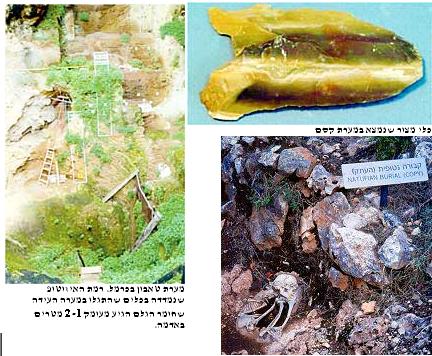The cave dwellers in Carmel endeavored to extract raw materials for making tools from the depths of the earth
Ran Shapira

Axes, knives and other tools made of flint are of improved quality and high durability, if the raw material from which they were made was extracted from the ground and not collected from the ground. This fact, known to today's researchers, was already known to some of the cave dwellers in the Middle East about 300 thousand years ago.
A team of Israeli researchers believes that some of the country's residents at that time took the trouble to mine flint from a depth of one meter to about two meters, in order to obtain quality raw material. The researchers came to this conclusion from a comparison between flint tools found in two prehistoric sites in Israel: Tabon Cave in Carmel and Kesem Cave, near Kfar Kasem.
The Tabun Cave, which was discovered in the late 20s, has been studied since 1973 by Prof. Avraham Ronen from the Institute of Archeology at the University of Haifa. The excavations at Kesem Cave, which was discovered in the summer of 2000, are managed by Prof. Avi Gofar and Dr. Ran Barkai from the Institute of Archeology at Tel Aviv University.
To check whether the raw material used to make the tools was collected from the ground or mined from it, a team led by Dr. Elisabetta Boerto, from the History Laboratory at the Kimmel Center for Archaeological Sciences at the Weizmann Institute, tested the level of the beryllium 10 isotope in the flint tools. This isotope was formed in rocks following exposure to cosmic radiation.
Dr. Buarto explains that flint found on the surface contains high levels of beryllium-10, because it has been exposed for millions of years to cosmic radiation. In contrast, flint that was buried in the ground contains low levels of the isotope.
One gram of flint that was on the ground has several million atoms of beryllium-10, while a gram of flint that was buried in the ground has several tens of thousands or hundreds of thousands of atoms of the isotope.
The researchers tested the level of the isotope in tools associated with the same material culture - the Ashlo-Hybrid culture - found in the two caves. The tools were uncovered in layers dated to the same period - between 350 thousand and 200 thousand years before our time. Samples of the flint from the two caves were tested in the Koffler particle accelerator at the Weizmann Institute. In an article published in the journal "Science of the National Academy of Proceedings", Boerto and her colleagues write that the flint vessels from Kesem Cave contained beryllium 10 at levels corresponding to the material found on the ground. The level of the isotope measured in the tools from the Tabun Cave testified that the raw material came from a depth of one to two meters in the ground.
According to Buarto, from this it can be concluded that the inhabitants of Tabun cave were more careful than their fellows about the quality of the raw material from which they made their tools. They knew that better tools could be made from the flint in the ground and worked to get it out of there. In contrast, the inhabitants of the Magic Cave collected flint that fell on their way. The method used to mine the flint is not clear. From measuring the levels of the beryllium 10 isotope, it is only possible to conclude if the flint vessels were made from raw material collected from the surface of the ground, or if it was necessary to dig deep into the ground to extract it.
https://www.hayadan.org.il/BuildaGate4/general2/data_card.php?Cat=~~~869863158~~~201&SiteName=hayadan
